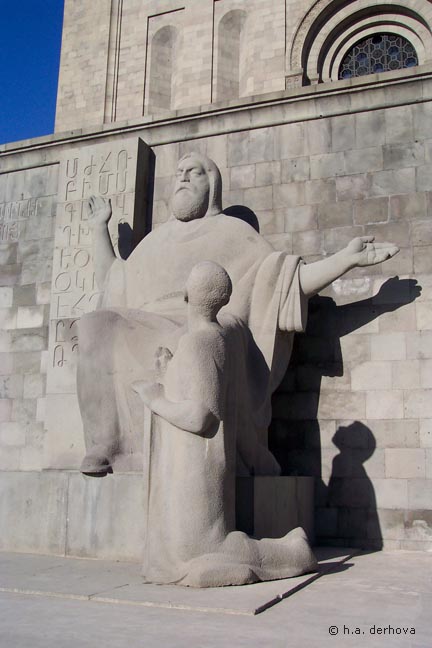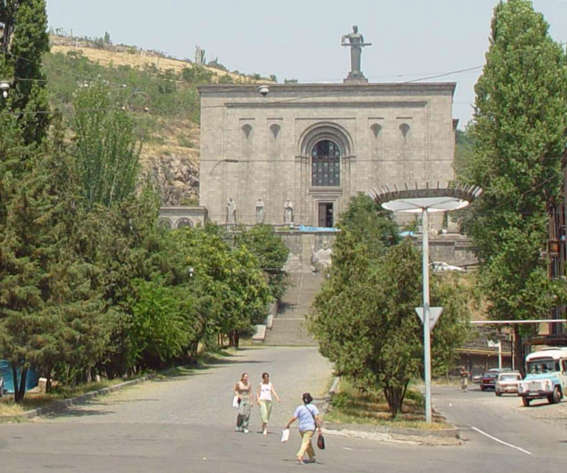The Matenadaran,
which in ancient Armenian means
‘‘manuscript store’’ or ‘‘library’’, is
a major centre for the study and
preservation of Armenian works of
literature. In ancient times and the
Middle Ages manuscripts were
reverentially guarded in Armenia, and
they played an important role in the
people’s fight against spiritual
subjugation and assimilation. The major
monasteries and universities had special
writing rooms, where skilled scribes
copied books by Armenian scholars and
writers, and Armenian translations of
works by foreign authors.
The scribes’ lot was not an easy one:
for tens of years they would sit in tiny,
dark rooms, hunched over manuscripts. It
is difficult to say how many of them
lost their sight, and how many of them
found an early grave because of their
job; how much indeed they suffered,
these humble people, saving books from
fire and pillage, how many of them were
killed there in their cells as they sat
working. Many manuscripts, like wounded
soldiers, bear the marks of sword, blood
and fire. The enemy buried them, drowned
them and even went so far as to chain
them up.
Those selfless scribes, thanks to whom
many of the treasures now in the
Matenadaran have come down to us,
thought not of themselves; they were
concerned only for their manuscripts.
Here is a touching inscription, appended
to the end of a book by a book-lover of
olden days:
- Reader
mine, I beg of thee
- Drink in
my words:
- Take my
book unto thyself, keep it and read
it.
- If it be
captured, retrieve it,
- place it
not in damp places, for it will
moulder,
- nor let
the wax of your candle drip upon it,
- neither
moisten your finger to turn the
pages,
- nor in
shameful fashion tear out its pages.
Tens of thousands of Armenian
manuscripts perished in the innumerable
invasions, wars and plundering raids.
Approximately 25,000 have survived,
including over 10,000 folios and also
2,500 fragments collected in the
Matenadaran. The rest of them are the
property of various museums and
libraries throughout the world, chiefly
in Venice, Jerusalem, Vienna, Beirut,
Paris, the Getty Museum in Los Angeles
and London.
The Matenadaran’s “holy of holies” are
the armoured cellars, equipped to
protect the manuscripts from dust and
damage.
The most ancient parchment book in the
stocks is the Gospel of Lazarus, written
in 887. There are other earlier
manuscripts which have come down to us
in fragments from the fifth to eighth
centuries. The most ancient paper
manuscript dates from 981.
Visitors to the Matenadaran, and there
are more than 50,000 annually (1982
figure), can see the best examples of
manuscript books and the wonderful
illustrations to them in the exhibition
hall on the first floor. There are works
on history, philosophy, mathematics,
medicine, astronomy and geography. On a
separate stand is the largest Armenian
manuscript in the world, weighing 34
kilograms. 700 calf skins were used in
its compilation. Next to this giant is a
tiny book measuring 3 x 4 centimetres
and weighing a mere 19 grams. Other
interesting exhibits include the Gospels
of 1053, 1193 and 1411 with the unfading
colours of their masterful miniatures,
translations from Aristotle, a unique
ancient Assyrian manuscript and an
ancient Indian manuscript on palm leaves
in the shape of a fan.
The Matenadaran’s manuscript collection
is of prime importance for the study of
the history and culture of Armenia, and
also alt Transcaucasia, Asia Minor and
many Middle Eastern countries. Works by
some philosophers of antiquity survived
only in their Armenian translation.
These include Eusebius of Gaesaria’s “Chronicle”,
the ancient Greek philosopher Xenon’s
treatise "On Nature" and many others.
The archives here are also rich,
preserving over 100,000 documents of the
fourteenth to nineteenth centuries:
various deeds, decrees, treaties and
letters, which contain vast material on
the political and socio-economic history
of Armenia and neighbouring countries.
Other relics in the exhibition include
the first Armenian printed book
“Parzatumar” (Explanatory Calendar),
published in 1512 in Venice and the
first Armenian magazine “Azdardr” (the
messenger) first published in 1794 in
the Indian city of Madras. Next to them
are the Decree on the founding of
Novo-Nakhichevan (a settlement near
Rostov-on-Don now included within the
city boundaries), signed by the Russian
Empress Catherine II, and Napoleon
Bonaparte’s signature. In 1978 the
writer Marietta Shaginyan presented the
Matenadaran with a previously unknown
document bearing the signature of Goethe.
The Matenadaran is constantly acquiring
manuscripts found in other countries.
Several hundred books dating from the
thirteenth to eighteenth centuries have
recently been sent by Armenians living
in Libya, Syria, France, Bulgaria,
Romania, India and the USA.
These precious items do not lie unused
in the Matenadaran: by carefully
studying the manuscripts, many of which
are restored in a special laboratory,
scholars in various fields can shed more
light on many aspects of the history and
culture of Armenia, the Caucasus as a
whole as well as the Middle East.
Experts in Armenia and Eastern studies
come from all over the world, and all
facilities are provided for their
research.
Yet one more manuscript is carefully
preserved here. Unlike all the others,
however, its pages have been filled in
our time. This is the visitor’s book,
which contains comments by prominent
scientists, major political and public
figures, writers, artists and actors.
This is the remark left in the book by
Leonid Brezhnev, General Secretary of
the Central Committee of the Communist
Party of the Soviet Union, Chairman of
the Presidium of the Supreme Soviet of
the USSR, when he visited the
Matenadaran on November 28, 1970:
"It
is with profound admiration that I
note the care with which Socialist
Armenia preserves the magnificent
relics of its people’s ancient
culture for present and future
generations
 |

Mesrop Mashtots statue at
Matenadaran. |

